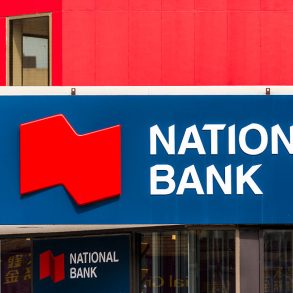
Another bank earnings season is in the bag. It was a quarter where Canada’s Big 6 banks addressed analysts about the changing regulatory landscape.
There was also a sharper focus on uninsured mortgage portfolios. National Bank analyst Peter Routledge addressed the issue in a recent note to clients: “With uninsured mortgages driving an increasing portion of overall mortgage and loan growth…the consequences of a decline in housing prices—most notably in the Toronto and Vancouver markets—weighs more heavily with each passing quarter.”
As usual, we’ve picked through the Big Banks’ quarterly earnings reports, presentations and conference calls, and compiled all the mortgage-related goodies here. Notable tidbits are highlighted in blue.
*********
 Bank of Montreal
Bank of Montreal
Q4 net income: $1.35 billion (+11% Y/Y)
Earnings per share: $2.10
- BMO’s total Canadian residential mortgage portfolio rose to $103.6 billion in Q4, up from $101.2 billion in Q3 and $97 billion in Q4 2015.
- In 2016, BMO’s mortgage portfolio grew approximately 6%.
- 56% of BMO’s portfolio is insured, down from 58% in Q4 2015.
- The loan-to-value on the uninsured portfolio is 54%, down from 56% in Q3 and 57% a year ago.
- 70% of the portfolio has an effective remaining amortization of 25 years or less, down from 71% a year ago.
- The condo mortgage portfolio stands at $14.7 billion (up from $14 billion in Q4 2015) with 49% insured (down from 51% a year ago).
- Loss rates for the trailing four-quarter period were less than 1 bp and the 90-day delinquency rate rose to 24 bps from 22 bps in Q3, but is down from 26 bps in Q4 2015.
- Net interest margin (NIM) in the quarter was 2.53%, down from 2.55% in Q4 2015.
Source: BMO Q4 Investor Presentation
Conference Call
- Regarding recent regulatory changes, Surjit Rajpal, Chief Risk Officer, said this: “It will take time for the impact of recent housing policy changes to fully materialize. However, our underwriting practices are prudent and position us well.”
- “…we are undersized in particular in Toronto where we’ve been making investments in positioning ourselves to do well in that market,” said Cam Fowler, Head of Canadian P&C. “(And in) the rest of Canada we’ve also been well-positioned with our proprietary sales force, which is I think stronger than it was before. So could the market slow a little bit in 2017? Yes. I expect that it would, but from a relative basis I would like us, and would expect us, to remain quite competitive in 2017.”
- Asked if the recent ~35 bps rise in 5-year rates is affecting the bank’s margins, Fower replied, “It’s not something we’re feeling yet.”
CIBC
Q4 net income: $2.01 billion (+9% Y/Y)
Earnings per share: $1.57
- CIBC’s residential mortgage portfolio rose to $181 billion in Q4, up from $175 billion in Q3 and up 11% from $163 billion in Q4 2015.
- Of the $181-billion mortgage portfolio, $25 billion is from the Greater Vancouver Area and $50 billion is from the Greater Toronto Area.
- Condos comprise $20 billion of those loans (up from $19 billion in Q2).
- 56% of the bank’s residential mortgage portfolio is insured (down from 57% in Q3). The uninsured portfolio has an average LTV of 56% (46% in the GVA and 53% in the GTA). That’s down from 57% in Q3 and 59% in Q4 2015).
- This year alone the bank originated $48 billion of uninsured mortgages, approximately 35% to clients in the GTA and 21% to clients in the GVA.
- The bank’s HELOC portfolio rose to $20.1 billion in the quarter, up from $19.5 billion a year earlier.
- Net interest margin in Q4 was 245 bps, down from 248 bps in Q3 and 254 bps in Q4 2015.
- “Uninsured mortgages in the Greater Vancouver Area (GVA) and Greater Toronto Area (GTA) have lower 90+ days delinquency rates than the Canadian average,” the bank noted in its investor presentation.
- “Less than 1% of (the bank’s uninsured mortgage) portfolio has a Beacon score of 650 or lower and an LTV over 75%.”
Source: CIBC Q4 Investor Presentation
Conference Call
- Victor Dodig, President and CEO, said, “During the year, we also introduced several innovative products and services for the convenience of our clients (such as) the capability for our clients to open an account or apply for a mortgage entirely through a mobile device.”
- On mortgage market share, Dodig said the following: “On revenue growth, we moved from lagging to leading with strong and balanced growth across lending, deposits, cards, mortgages, business banking and other product areas… In mortgages we have made significant progress in growing with our clients. Our portfolio is now predominantly composed of CIBC mortgages sourced from our own sales force. As a result, we have much deeper relationships with our mortgage clients today than we did four years ago when one third of our business was broker based.”
- Asked whether the mortgage loan was impacted by the government’s recent rule changes, David Williamson, SEVP and Group Head, Retail and Business Banking, said the growth has been “more a function of…the building of our proprietary sales force.”
- Williamson said CIBC originally hoped to transition 25% of FirstLine clients over to CIBC and build up its own sales force. “We actually transitioned above 50% of FirstLine into CIBC and our proprietary sales force has … been very effective in driving deep relationships.”
- Looking forward, Williamson conceded that recent regulatory changes “will result in price changes and ebbing in growth rates.”
- “During 2016 we adjusted lending criteria not just in mortgages but in other areas of loan book…,” Dodig added.
- “Our late stage delinquency rates across the portfolio continue to remain low and stable with the Vancouver and Toronto areas performing significantly better than our Canadian average,” Dodig said.
- Asked if the bank expects to cede some of its margins in order to grow market share, Williamson replied: “(I’m) not comfortable ceding margin … we are fourth in the marketplace and we are a price taker. So we will not and are not competing on price. But I am comfortable with relatively stronger growth rates…”
- He listed strong Beacon scores (particularly in Toronto and Vancouver), relatively low loan-to-value ratios for uninsured mortgages in B.C., and “deep” and “sustainable” client relationships as reasons for his optimism.
- Asked if there is concern about the rate of mortgage balance growth of approximately 23% in the GTA and GVA, Dodig replied: “I’ll just highlight a couple of factors. One is the loan-to-value of the mortgages that we are originating in the GVA, (which) shows a tremendous amount of buffer… our loan-to-value, the business we are booking is more conservative than when you compare against our peers… (and) we look at the nature of the business through our book (as being) very balanced, we are not just seeing jumbo mortgages with no other relationships. We are seeing, whether it’s coming through our mobile channel or whether it’s just the business specifically in Vancouver, our deep relationships that are coming with deposits, so the foreign investor and the new immigrants not just taking a mortgage they are showing up with funds…”
- CIBC was recently the subject of a BMO research report that found 3-4% of its uninsured residential mortgage portfolio is in the “red zone,” which is defined as having a sub-640/650 credit score and greater-than-65% LTV.
- “Its exposure to the ‘red zone’ is ~15% of its CET1 capital, more than double the next highest,” the authors wrote. “This analysis confirms our earlier observation that in a Canadian housing-related tail risk scenario, CIBC looks to have notably more exposure, adjusted for its size, relative to the peer group.”

National Bank of Canada
Q4 net income: $307 million (-11.5% Y/Y)
Earnings per share: $0.78 a share
- The bank’s residential mortgage and HELOC portfolio rose to $58.2 billion in Q4, up from $57.8 billion in Q3 and $54 billion in Q4 2015.
- The bank said its loan portfolio is “concentrated in regions with stronger job growth.”
- The portfolio is 43.1% insured (vs. 41.9% in 2015), 22.9% uninsured (vs. 24.1% in 2015) and 34% HELOCs (unchanged from Q4 2015).
- The average loan-to-value on the HELOC and uninsured mortgage portfolio was 59%, unchanged from Q3 and Q4 2015.
- Quebec represented 61% of the mortgage book in Q4, up from 60% in Q3. Ontario was 23% (unchanged) and Alberta represented 6% (unchanged).
- Net interest margin in Q4 was up 1 bp both Q/Q and Y/Y to 2.26%.
Source: National Bank Q4 Investor Presentation
- In October the bank reported that it will eliminate 600 jobs over the next year and offer early retirements or other positions to another 300 workers as part of its restructuring and shift to a digital economy. At the same time it will hire about 500 people, particularly in sales and service, and information technology positions.
Conference Call
- Asked about the bank’s decision to leave the mortgage broker channel and what was behind that decision, Louis Vachon, President and CEO, said: “…let me say that the agreement is final for us. We’ll originate, underwrite and service…broker channel mortgages on our behalf under the Merix Financial brands. We believe the arrangement with Paradigm Quest provides the best economics for the bank and this is part of our efficiency program. But most importantly and strategically, it allows us to redeploy our resources, mainly our IT spend, in creating e-mortgages capabilities, and that’s obviously to satisfy our clients evolving needs. The first iteration of our e-mortgage is expected towards the end of this fiscal year. We’re still committed to the brokerage channel and understand that this transition from broker to digital facilities will take some time. But we wanted to go ahead with this and make sure that we’re there when clients change their behaviour. Our goal is definitely to originate the same volume as we are today in our current model.”
- Asked if the bank expects the change to impact margins at all, Jean Dagenais, Senior VP Finance, replied, “No, we’re not … we’re expecting flat margins for next year.”
(National Bank Conference Call)
Royal Bank of Canada
Q4 net income: $2.54 billion (-2% Y/Y)
Earnings per share: $1.65
- Residential mortgage volume rose to $221 billion in Q4 from $216 billion in Q3, up 1.9% Q/Q and 5.9% Y/Y.
- 53% of its mortgages are uninsured, up from 52% from last quarter.
- The bank noted, “While residential mortgage delinquencies increased in oil-exposed provinces, they were stable nationally.”
- 30+ day delinquencies in the residential mortgage portfolio were 0.19%, flat from Q3 and down from 0.21% a year ago.
- RBC’s condo exposure is 9.8% of its mortgage portfolio (unchanged from Q3).
- The bank noted that average FICO scores of 782 on residential lending remains high, “indicating strong customer credit quality.”
- RBC repeated this line from its Q3 investor presentation: “GTA and GVA average FICO scores are above the national average; with Alberta in line with the national average.”
- Average remaining amortization on mortgages is 18 years, unchanged from Q3.
- Net interest margin was 2.63%, unchanged from the last quarter and down from 2.65% a year ago.
Source: RBC Q4 Investor Presentation
Conference Call
- “Our mortgage volumes continue to grow at a premium to the market, driven by expanded mortgage sales force, focused on key client segments such as newcomers, as well as the return of our successful employee pricing campaigns,” said President and CEO David McKay.
- McKay noted that clients can now use RBC Rewards to pay down their mortgage.
- On the recent regulatory changes, McKay said, “While the changes may weigh on mortgage growth for certain client segments, we see opportunities in others. We also believe these changes could ultimately help curb the tail risk associated with long-term slow-down of economic growth.”
- He added: “…in the absence of any monetary tightening, we need the policy changes that we’re seeing to slow down some very hot markets out there.”
- Asked if the mortgage rule changes may benefit big banks such as RBC at the expense of smaller players in the market, McKay replied, “Certainly there are smaller players in the market whose funding model will be impacted and you should expect to see some channel shifts. And we would hope to be the beneficiary of that with our expanded sales force. How that plays out is hard to predict, but certainly there are more challenges to some of the smaller players in the market who’ve relied on traditional funding models.”
- “Overall we remain comfortable with the risk profile of our residential mortgage portfolio,” McKay said. “Our clients’ credit profiles remained strong, with low LTVs and high FICO scores. Many clients are also committed to increase down payments, fixed mortgage rates and accelerated repayment plans, reinforcing our confidence in our clients’ ability to repay.”
- McKay added: “Our impaired rates remain low, especially in Greater Toronto and Vancouver. However, given the elevated house prices in both Greater Toronto and Vancouver areas, as well as the recent announcements by the Department of Finance, we continue to actively monitor this portfolio. Overall, I’m pleased with our credit performance this year, with total annual PCL of 29 basis points, which is slightly below our historical range of 30 to 35 basis points.”
- “There continues to be supply constraints in a number of key markets, particularly the GTA, which is giving prices support and price inflation, which you’re not seeing as demand starts to fall off in Vancouver, and some of that is actually shifting into the GTA,” McKay said. “So you’re seeing healthy demand creation, you’re still seeing relatively healthy housing starts; you’re seeing good capacity uptakes. So there will be a moderation in supply and therefore there will be somewhat of a moderation on the impact in GDP going forward, I think you should expect that.”
- Asked about changes to the bank’s fixed rate mortgage margins, Jennifer Tory, Group Head, Personal & Commercial Banking, said this: “So we’ve seen continuing pressure on our margins, and so if you saw on November 16, we revised our variable and fixed rate mortgage pricing. …We review on a daily basis our rates to make sure we continue to grow our business and meet client expectations. The price changes are only on newly originated loans…we don’t anticipate an uplift in NIM in the near term, but we did want to address some of the pressure that was in the rate environment.”
Scotiabank
Q4 net income: $2.01 billion (+9% Y/Y)
Earnings per share: $1.57
- The total portfolio of residential retail mortgages rose to $193.3 billion in Q4, up from $191.1 billion in Q3 and $190 billion in Q4 2015.
- The portfolio was comprised of $170 billion in freehold properties (up from $169 billion in Q3) and $23 billion in condos (up from $21 billion in Q3).
- 57% of the residential mortgage portfolio was insured in Q4, down from 59% in Q3 and up from 49% in Q4 2015.
- The average LTV of the uninsured portfolio was 50%, down from 53% a year ago.
- Net interest margin was 2.39% in the quarter, up from 2.38% in Q3 and up from 2.26% in Q4 2015, “driven primarily from higher earning assets and improved deposit margin. The positive impact from acquisitions was 5 bps.”
Source: Scotiabank Q4 Investor Presentation
Conference Call
- Addressing the recent mortgage regulatory changes, Sean McGuckin, Chief Financial Officer, said: “The most recent changes related to the borrowers’ qualifying rate, reduced active portfolio insurance, limiting of foreign owners, homeowners’ ability to claim a principal resident to avoid capital gain stacked on the sale of the residence and proposed risk sharing. By and large, these changes will moderate residential mortgage loan growth, but over time, we are optimistic we will maintain and grow profitable market share.”
- “On mortgage risk sharing…overall, it is still too early to provide exact impact to the market as there are both potential positives and negatives including potentially improved margins and volumes in certain mortgage types,” McGuckin said. “Turning to competition in the residential mortgage market, it remains intense but from our standpoint, the environment has improved from earlier this year.”
- McGuckin continued, “Overall, we remain comfortable with our mortgage lending exposure and expect growth to be in the low single digits. We agree in some cases, the level of housing price appreciation and growth is not sustainable and generally welcome regulatory changes that help moderate the market.
TD Bank
Q4 net income: $2.3 billion (+20% Y/Y)
Earnings per share: $1.22
- TD’s residential mortgage portfolio rose to $189 billion, up from $187.7 billion in Q3 and 184.5 billion in Q4 2015.
- The bank’s HELOC portfolio rose to $65 billion, up from $63.9 billion in Q3 and $61.2 billion a year earlier.
- 50% of the portfolio is insured, down from 51% in the previous quarter and 56% a year ago. The loan-to-value of the uninsured portfolio is 58%, unchanged from Q3.
- Within the residential mortgage portfolio, gross impaired loans declined to $401 million, or 0.21%, down from $406 million or 0.22% in Q3. Among the HELOC portfolio, gross impaired loans also fell from $155 million (0.24%) to $149 million (0.23%).
- Net interest margin was 2.78%, down from 2.79% in Q3.
Source: TD Bank Q4 Investor Presentation
Conference Call
- Bharat Masrani, President and CEO, outlined TD’s latest digital innovation to drive engagement with clients: “This fall we launched TD for Me; a new capability integrated with our TD Banking App. If you visit our real estate development site served by a TD Mobile Mortgage Specialist in a TD for Me zone, you’ll get a push notification on your home screen connecting you with an advisor who can answer your questions and guide you through the process of getting a mortgage.”
- Asked about the bank’s recent mortgage rate increases and how that will affect TD’s margin outlook, Teri Currie, Group Head, Canadian Personal Banking, said: “We expect as we look ahead to 2017 that that margin compression that we’ve experienced this year will moderate over the full year. There will be bumpiness in quarters, but we should expect it to moderate in the next year and obviously when you look at the re-pricing, when the re-pricing is only for new originations or renewals, that takes a bit of time to work its way through the mortgage book.”
Note: Transcripts are provided by a third party (Seeking Alpha) and their accuracy cannot be 100% assured.
Steve Huebl & Rob McLister, CMT







